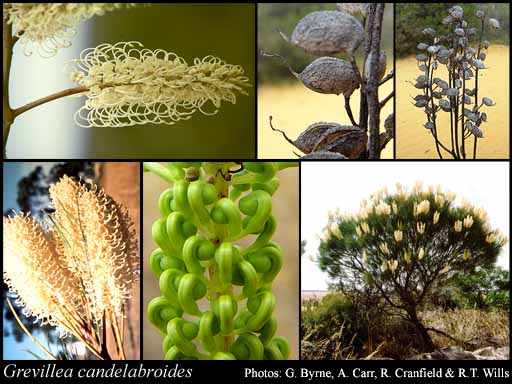- Reference
- J.Roy.Soc.Western Australia 47:56 (1964)
- Conservation Code
- Not threatened
- Naturalised Status
- Native to Western Australia
- Name Status
- Current
Non-lignotuberous shrub, 1.2-4 m high. Fl. cream-white, Apr or Aug to Dec or Jan. White or yellow sand, sandy clay.

Scientific Description
Shrubs, 3-5 m high; branchlets glabrous, not glaucous. Leaves alternate, 120-200 mm long, hairy, on the abaxial surface, the hairs straight; lamina flat, once divided, pinnately divided, divided to the midrib; lobes 50-160 mm long, 0.8-1 mm wide, the margins revolute, enclosing the lower surface of the leaf blade, forming a groove either side of the midvein. Inflorescences terminal, white or cream; pedicels 4-6 mm long. Perianth 6-8 mm long; tepals all free after flower opens, glabrous; ovary glabrous, stipitate, the stipe 2-3 mm long; pistil 10-14 mm long, white or cream, pollen presenter oblique, style glabrous. Follicles glabrous, viscid, dehiscent, 13-15 mm long. Flowers in January, August, September, October, November or December. Occurs in the Eremaean (ER) or South-west (SW) Botanical Province(s), in the Great Sandy Desert (GSD), Yalgoo (YAL), Geraldton Sandplains (GS) or Avon Wheatbelt (AW) IBRA subregion(s).
Distribution
- IBRA Regions
- Avon Wheatbelt, Geraldton Sandplains, Yalgoo.
- IBRA Subregions
- Edel, Geraldton Hills, Lesueur Sandplain, Merredin, Tallering.
- IMCRA Regions
- Central West Coast.
- Local Government Areas (LGAs)
- Carnamah, Chapman Valley, Coorow, Greater Geraldton, Irwin, Mingenew, Northampton, Shark Bay, Three Springs.